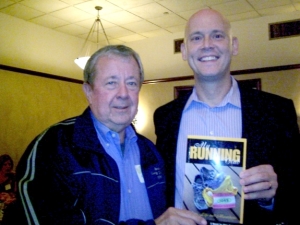Social Running Beats Solo Running
 Social running beats solo running.
Social running beats solo running.
“Social running” happens when family members, friends, business associates, or even all of the above get together to run.
You might want to include races in those get-togethers, but let me focus on training runs for the purpose of this article. After all, even solo runners participate in races!
I WOULD include get-togethers organized by group training programs, such as the fictional program described by Alan Anderson in his engaging book My Running Club: A Novel of Love, Life and Marathons.
Running with others beats running alone.
Let me try to prove it to you.
Inspiration
If you run with others, and if you truly listen to their stories about how they have overcome adversity in their training and racing, you cannot help but be inspired — knowing that you are not the only runner facing setbacks, trials, and tribulations.
Camaraderie
If you run with others, you get to enjoy camaraderie. One definition of camaraderie is the spirit of familiar trust among friends. On the road or trail, this usually means that you can use your runs to work out problems — or at least to get fresh perspectives — with non-running issues, knowing that others can keep your confidence.
Advice
If you run with others, you eventually will get their advice on SOME aspect of your running. Their advice could be about your foot-fall. It could be about your breathing. It could even be about your stride up a hill, holding your chin up as you run, or some mental trick to try in your next race. You may not always immediately appreciate the advice, but you typically will recognize in the long run how much your fellow runners want YOU to succeed, too.
Recommendations
If you run with others, you very likely will get their recommendations — on everything from upcoming races (my favorite) to what they prefer in their energy gels, their socks, and their hydration devices. Of course, each individual runner’s recommendations will come from his or her own very personal experience, but compiling recommendations from several fellow runners can give you composite recommendations that will help you to avoid training and racing mistakes and setbacks.
Examples
If you run with others, you can get great examples — of how to be kind to oneself, of how to be kind to others, of how to sacrifice for another, and of how to be grateful for truly any aspect of a run.
Bottom Line
Did you notice something about these five benefits?
The acronym “I CARE” comes from their first letters.
This “I CARE” concept — knowing that other runners care about you and that you get to care about them — may be the key to the happiness that you can enjoy as a social runner (or walker).